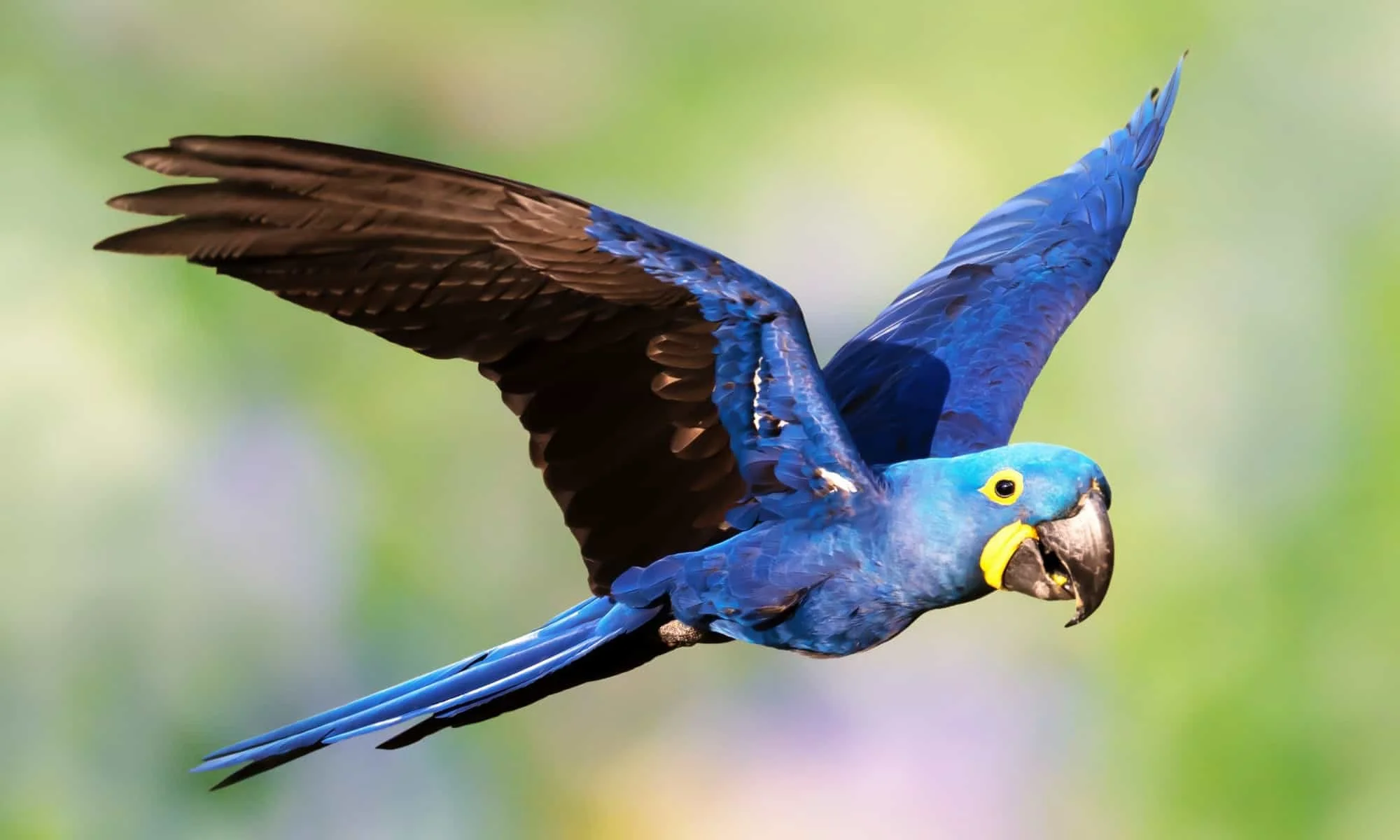Recent Publications
Conservation outlooks and reviews from Earth BioGenome Project (EBP)-affiliated projects
In the last 5 years, EBP-affiliated projects have written several detailed reviews highlighting the importance of high-quality reference genomes to conservation genomics. These publications demonstrate how high-quality reference genomes can support and advance conservation genomics research, which in turn can inform conservation policies. Closing the gap in reference genomes, especially for the estimated 46,300 species currently threatened with extinction (IUCN, 2024), is a critical step toward better protecting threatened species and preserving global biodiversity for future generations.
Red-shanked douc langur (Pygathrix nemaeus) is currently found in parts of Laos, Vietnam, and Cambodia, is listed as a critically endangered species, and its population size is decreasing according to the IUCN Red List (Coudrat et al., 2020). This reference genome was sequenced by the 200 Mammals Project.
Reference genomes for conservation
High-quality reference genomes for non–model species can benefit conservation.
“Addressing biodiversity loss is a complex problem that requires multifaceted solutions. Genomics can be an important component of conservation management. It is urgent that high-quality reference genome assemblies and cryopreserved cells be produced for endangered species now and, eventually, for all species.”
Vertebrate genomes project (vgp)
Authors: Paez S, Kraus RH, Shapiro B, Gilbert MT, Jarvis ED, Vertebrate Genomes Project Conservation Group.
Journal: Science 377, no. 6604
Published: 2022
Translating genomic advances into biodiversity conservation
“Conservation management actions and associated legislation should be based on the best possible available evidence. There have been sizable efforts by the scientific community in recent years to develop evidence-based decision tools and frameworks for protecting biodiversity, many of which integrate genomic data. However, large-scale investment is the only true way to move the fields of biodiversity and conservation genomics from the academic sector into the applied conservation and policy sectors for biodiversity protection.”
Threatened Species Initiative (TSI)
Hogg, Carolyn J.
Journal: Nature Reviews Genetics 25, no. 5
Published: 2024
Ninu (Macrotis lagotis) is currently found in the greater sandy desert region of Australia, is listed as a vulnerable species, and its population size is decreasing according to the IUCN Red List (Burbidge and Woinarski, 2016). This reference genome was sequenced by the Threatened Species Initiative and BioPlatforms Australia. Photo taken by Yuanyuan Cheng.
African Savanna Elephant (Loxodonta africana) is currently found primarily in eastern and southern Africa, is listed as an endangered species, and its population size is decreasing according to the IUCN Red List (Gobush et al., 2022). This reference genome was sequenced by the Vertebrate Genomes Project.
Africa: sequence 100,000 species to safeguard biodiversity
Build a major genomics resource on the continent to help breeders and conservationists.
“Around 95% of Africa’s endangered species are currently unsequenced.”
African BioGenome Project (Africa-BP)
Authors: Ebenezer T.E., Muigai A.W., Nouala S., Badaoui B., Blaxter M., Buddie A.G., Jarvis E.D., Korlach J., Kuja J.O., Lewin H.A., Majewska R. , Mapholi N., Maslamoney S., Mbo’o-Tchouawou M., , Osuji J.O., Seehausen O., Shorinola O., Tiambo C.K., Mulder N., Ziyomo C., and Djikeng A.
Journal: Nature, 603(7901), pp.388-392.
Published: 2022
The Amphibian Genomics Consortium: advancing genomic and genetic resources for amphibian research and conservation.
“We hope that the recent advancements in technology, a focus on equitable research, and the integration of the research community to form the AGC will ignite research to revolutionize amphibian conservation and our understanding of their fascinating biology, ecology and evolution.”
Amphibian Genomics Consortium (AGC)
Authors: Kosch T.A., Torres-Sánchez M., Liedtke H.C., Summers K., Yun M.H., Crawford A.J., Maddock S.T., Ahammed M.S., Araújo V.L., Bertola L.V., Bucciarelli G.M., Carné, Carneiro, Chan, Chen, Crottini, da Silva, Denton, Dittrich, Themudo, Farquharson, Forsdick, Gilbert, Che, Katzenback, Kotharambath, Levis, Márquez, Mazepa, Mulder, Müller, O’Connell, Orozco-terWengel, Palomar, Petzold, Pfennig, Pfennig, Reichert, Robert, Scherz, Siu-Ting, Snead, Stöck, Stuckert, Stynoski, Tarvin, Valero, and The Amphibian Genomics Consortium
Journal: BMC genomics, 25(1), p.1025.
Published: 2024
Hourglass Treefrog (Dendropsophus ebraccatus) is found in parts of central America, Colombia, and Ecuador. This species is not threatened according to the IUCN Red List (IUCN SSC, 2020). This reference genome was sequenced by the Vertebrate Genomes Project.
Hyacinth Macaw (Anodorhynchus hyacinthinus) is currently found in three main regions of Brazil, is listed as a vulnerable species, and its population size is decreasing according to the IUCN Red List (BirdLife International, 2016). This reference genome was sequenced by the Vertebrate Genomes Project.
Leveraging genomes to support conservation and bioeconomy policies in a megadiverse country
“Here, we share experiences that provide an outlook of the future for other Global South and megadiverse countries in the pursuit of setting up biodiversity-focused genome networks.”
Genomics of the Brazilian Biodiversity (GBB)
Authors: Vilaça S.T., Vidal A.F., Pavan A.C.D.O., Silva B.M., Carvalho C.S., Povill C., Luna-Lucena D., Nunes G.L., Figueiró H.V., Mendes I.S., Bittencourt J.A.P., Gomes Côrtes L., Canesin LE.C., Oliveira R.R.M., Damasceno R.P., Vasconcelos S., Barreto S.B., Tavares V., Oliveira G., Martins A.B., and Aleixo A.
Journal: Cell Genomics 4, no. 11
Published: 2024
Landscape genomics to enable conservation actions: the California Conservation Genomics Project
“By identifying, protecting, and connecting landscapes that harbor genomically diverse individuals and populations of many species, we increase the likelihood of preserving both the individuals, and the evolutionary processes, that allow populations to rapidly adapt to changing conditions.”
California Conservation Genomics Project (CCGP)
Authors: Shaffer H.B., Toffelmier E., Corbett-Detig R.B., Escalona M., Erickson B., Fiedler P., Gold M., Harrigan R.J., Hodges S., Luckau T.K., Miller C., Oliveira D.R., Shaffer K.E., Shapiro B., Sork V.L., and Wang I.J.
Journal: Journal of Heredity, 113(6), pp.577-588.
Published: 2022
Mexican flannelbush (Fremontodendron mexicanum) is currently found only in southern California and Baja California, Mexico, is listed as endangered, and its population size is decreasing according to the IUCN Red List (Carrero, 2022). This reference genome was sequenced by the California Conservation Genomics Project. Photo credit: Anna Leavitt.
references
BirdLife International. “Anodorhynchus hyacinthinus. The IUCN Red List of Threatened Species 2016: e.T22685516A93077457.” (2016) website: https://dx.doi.org/10.2305/IUCN.UK.2016-3.RLTS.T22685516A93077457.en. (Accessed on 20 February 2025.) Anodorhynchus hyacinthinus page on IUCN: here.
Burbidge, A.A. & Woinarski, J. “Macrotis lagotis. The IUCN Red List of Threatened Species 2016: e.T12650A21967189.”(2016) website: https://dx.doi.org/10.2305/IUCN.UK.2016-2.RLTS.T12650A21967189.en. (Accessed on 20 February 2025.) Macrotis lagotis page on IUCN: here.
Carrero, C. “Fremontodendron mexicanum. The IUCN Red List of Threatened Species 2022: e.T144220531A173847745.” (2022) website: https://dx.doi.org/10.2305/IUCN.UK.2022-1.RLTS.T144220531A173847745.en. (Accessed on 20 February 2025.) Fremontodendron mexicanum page on IUCN: here.
Challis, Richard, Sujai Kumar, Cibele Sotero-Caio, Max Brown, and Mark Blaxter. "Genomes on a Tree (GoaT): a versatile, scalable search engine for genomic and sequencing project metadata across the eukaryotic tree of life." Wellcome Open Research 8 (2023).
Coudrat, C.N.Z., Quyet, L.K., Duc, H., Phiaphalath, P., Rawson, B.M., Nadler, T., Ulibarri, L. & Duckworth, J.W. “Pygathrix nemaeus. The IUCN Red List of Threatened Species 2020: e.T39826A17941247.” (2020) website: https://dx.doi.org/10.2305/IUCN.UK.2020-2.RLTS.T39826A17941247.en. (Accessed on 20 February 2025.) Pygathrix nemaeus page on IUCN: here.
Genomes on a Tree (GoaT). Website: https://goat.genomehubs.org/projects/EBP Access date: February 20, 2025.
IUCN. “The IUCN Red List of Threatened Species. Version 2024-2.” website: https://www.iucnredlist.org. (2024): Accessed on (10 February 2025).
IUCN SSC Amphibian Specialist Group. 2020. Dendropsophus ebraccatus. The IUCN Red List of Threatened Species 2020: e.T55470A53954856. https://dx.doi.org/10.2305/IUCN.UK.2020-1.RLTS.T55470A53954856.en. Accessed on 24 February 2025. Dendropsophus ebraccatus page on IUCN: here.
Gobush K.S., Edwards C.T.T, Balfour D., Wittemyer G., Maisels F. and Taylor, R.D. “Loxodonta africana (amended version of 2021 assessment). The IUCN Red List of Threatened Species 2022: e.T181008073A223031019.” (2022) website: https://dx.doi.org/10.2305/IUCN.UK.2022-2.RLTS.T181008073A223031019.en. Accessed on 20 February 2025. Loxodonta africana page on IUCN: here.







